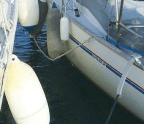Reefing to sail through any weather

World-renowned racer and adventurer, Pete Goss has sailed more than 250,000 miles both racing and cruising

There is nothing more rewarding on reducing sail than to feel a boat’s relief as she settles comfortably to a rising wind and sea. The easier, more upright motion often helps increase the speed, loads are reduced and the crew imbued with confidence. The decision to make that first of many reductions, followed by the attendant battle to actually get the reef in, is when the initiative is wrestled from the increasingly threatening conditions back to the crew. It’s the first reef that settles the nerves as you mentally brace for the storm that’s soon to come.
No matter how conservatively we passage plan, even on short trips, there will always be a blow that needs to be dealt with, and preparation is the answer in both training and equipment.
As a starting point, you should get to know your boat intimately so that she can talk to you in her own language, be it through motion, creeks or the kick of the helm. It’s no good sailing by wind speed alone because the numbers can be way off the mark, and wind strengths will feel different in varying seasons and climates. During the British Steel Challenge I recorded every sail change and found that we could carry head sails in warm dry Mediterranean conditions in up to 15 knots more wind speed than in wet heavy airs farther north.
I am reminded of an experienced skipper swaggering down to a strong aluminium 40ft Dutch yacht in the Outer Hebrides. He was about to set off on the next leg of the two-handed round Britain race and there was a nasty gale in the offing. Knowing the waters I warned him that perhaps he consider delaying for 12 hours as the density of cold air gives teeth to the wind up here. My heart sank at his bombastic reply: ‘I’ve handled stronger winds than these.’ Try as I might he just wasn’t for turning.
The Mayday came in later that day; the lifeboat was damaged by a knockdown during the callout. The subdued Dutchman suffered a broken rib, the yacht had extensive damage including a broken frame
You’re reading a preview, subscribe to read more.
Start your free 30 days





